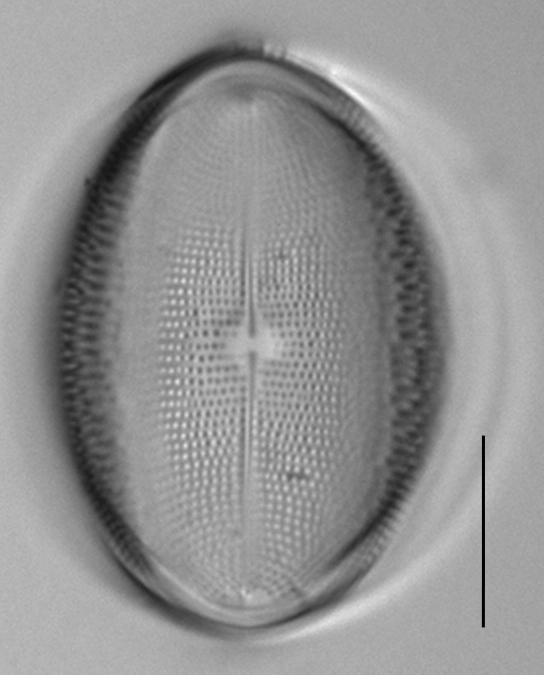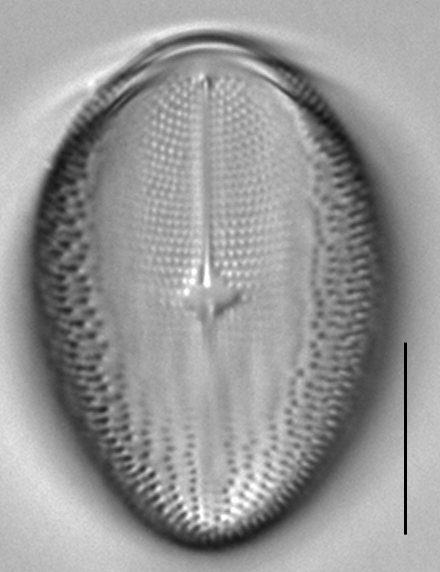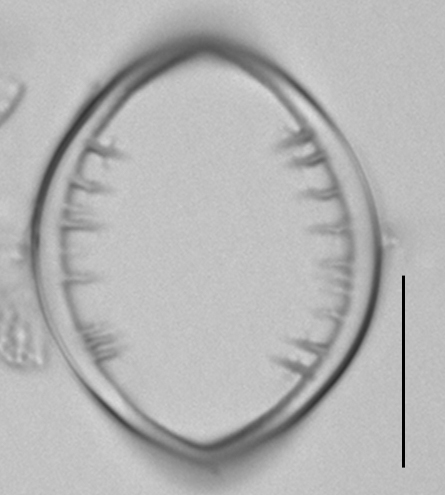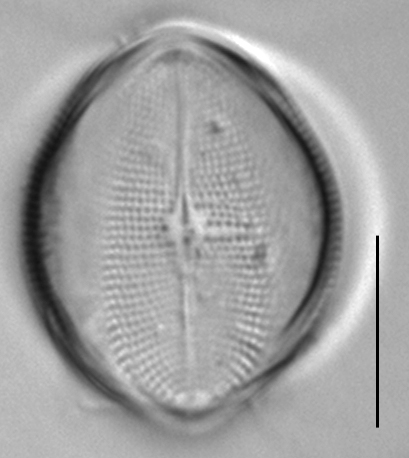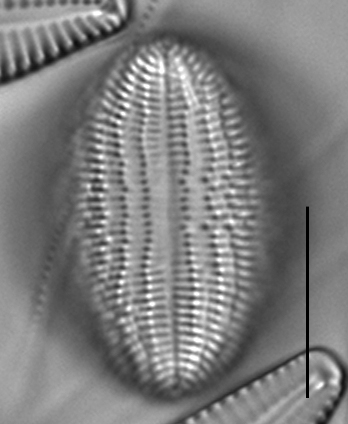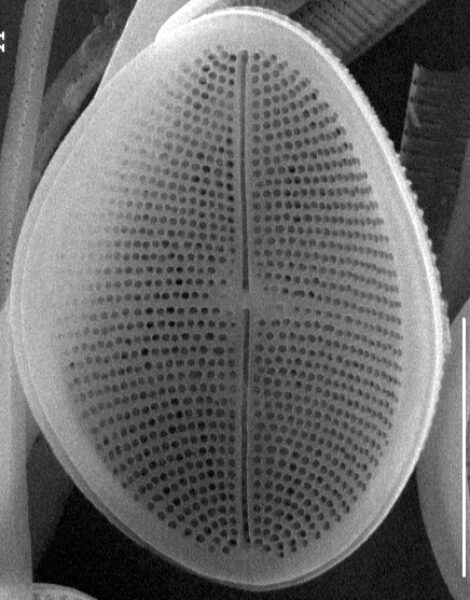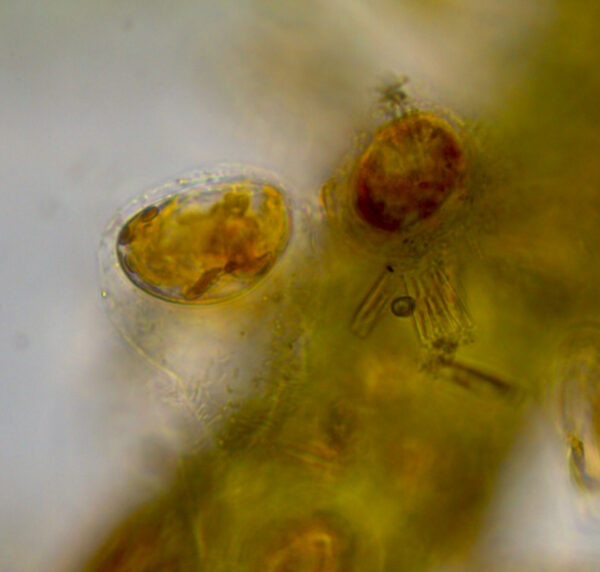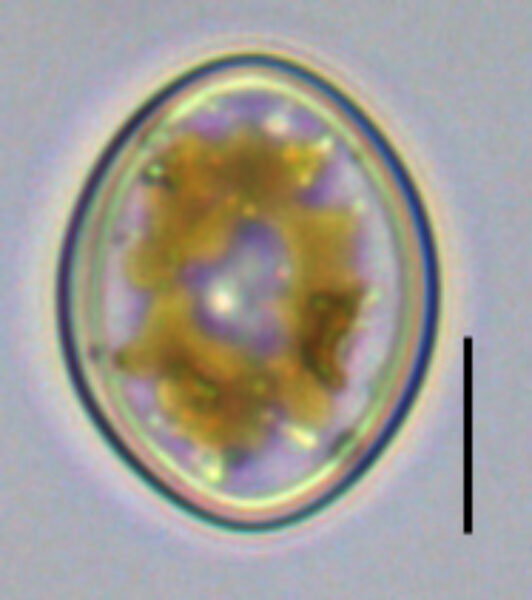Cocconeis pediculus
-
Category
-
Length Range17.0-41.5 µm
-
Width Range14-23 µm
-
Striae in 10 µm16-22 in the raphe valve center, 16-21 in the rapheless valve center
-
ContributorCatharina Grubaugh, Marina Potapova - Jun 2012
-
ReviewerKalina Manoylov - Jul 2012
Identification
Description
Valves are subcircular to broadly elliptic-lanceolate with curved to slightly pointed apices. The frustule is bent into a saddle-shape, with the raphe valve face transapically concave. The axial area of the raphe valve is narrow with a small, irregular central area. The terminal raphe fissures are straight. The proximal raphe ends are straight, and the raphe extends into the central area. The rapheless valve is transapically convex with a narrow sternum running down the middle. Striae are uniseriate on both valves. In the middle of the valves, striae are parallel, and striae closer to the apices are progressively more radiate and curved. On the raphe valve, the striae end before reaching the valve margin, forming an unornamented ring, which is wider on the sides of the valve than at the apices. Striae continue to the valve margin on the rapheless valve. Areolae are small and punctate on the raphe valve, and there are 17-24 areolae in 10 μm. On the rapheless valve, the areolae are narrow and transapically elongate. There are 6-11 areolae in 10 μm on the rapheless valve. The valve length-to-width ratio ranges from 1.1 to 1.6. The valvocopula may separate from the valve in prepared samples and appears as a ring with small projections that extend into the cell.
Jahn et al. (2009) examined the original material of Ehrenberg for Cocconeis pediculus and Cocconeis placentula var. placentula, including emended species descriptions and designation of epitypes.
Autecology
Cocconeis pediculus was found in an epilithon sample from the Bronx River, southeastern New York state (early April); in plankton, epiphyton, epipelon, and epilithic samples from Lake Okoboji, Dickinson County, Iowa (late May); and in high abundance in a epilithon sample from Grove Lake, Antelope County, Nebraska (late May). The Reimer Collection at Iowa Lakeside Lab contains C. pediculus specimens collected from late May to early August from planktonic, epiphytic, epilithic, and benthic habitats in various aquatic systems in Dickinson County, Iowa. In addition, the collection has specimens of C. pediculus from a dry epilithic sample at Skunk River, Story County, Iowa taken in late July; Brewer’s Creek, Hamilton County, Iowa taken in late October; and an epilithic sample at Shell Rock River, Cerro Gordo County taken in late May.
Patrick and Reimer (1966) noted that Cocconeis pediculus is sometimes considered a pollution tolerant species, while Lange-Bertalot classified C. pediculus as pollution intolerant (Brown and Olive 1995). The EMAP assessment shows that C. pediculus can be found in a relatively wide range of environmental conditions.
Cocconeis pediculus has also been reported in periphyton samples from the upper reaches of the Cuyahoga River, which flows into Lake Erie (Brown and Olive 1995). In a study of Cladophora epiphyton in Lake Ontario, C. pediculus dominated the diatom community, which the authors hypothesized may be due to stronger attachment to the substrate or to greater resource use efficiency (Malkin et al. 2009). Other reports of C. pediculus include southern California in the Salton Sea, which C. pediculus likely entered via inflow from freshwater streams (Lange and Tiffany 2002), and the Colorado River, where C. pediculus was particularly abundant in the upstream regions of this reach near Lees Ferry and Nankoweap Creek (Hardwick et al. 1992).
-
Size Range, µm3
-
Motility
-
Attachment
-
Habitat
-
Colony
-
BCG
-
Waterbody
-
Distribution
- Learn more about this
Citations & Links
Citations
-
Publication Link: 10.1023/A:1016550205461
Links
-
Index Nominum Algarum
-
GenBank
-
North American Diatom Ecological DatabaseNADED ID: 16011
Cite This Page
Grubaugh, C., Potapova, M. (2012). Cocconeis pediculus. In Diatoms of North America. Retrieved April 25, 2024, from https://diatoms.org/species/cocconeis_pediculus
Responses
The 15 response plots show an environmental variable (x axis) against the relative abundance (y axis) of Cocconeis pediculus from all the stream reaches where it was present. Note that the relative abundance scale is the same on each plot. Explanation of each environmental variable and units are as follows:
ELEVATION = stream reach elevation (meters)
STRAHLER = distribution plot of the Strahler Stream Order
SLOPE = stream reach gradient (degrees)
W1_HALL = an index that is a measure of streamside (riparian) human activity that ranges from 0 - 10, with a value of 0 indicating of minimal disturbance to a value of 10 indicating severe disturbance.
PHSTVL = pH measured in a sealed syringe sample (pH units)
log_COND = log concentration of specific conductivity (µS/cm)
log_PTL = log concentration of total phosphorus (µg/L)
log_NO3 = log concentration of nitrate (µeq/L)
log_DOC = log concentration of dissolved organic carbon (mg/L)
log_SIO2 = log concentration of silicon (mg/L)
log_NA = log concentration of sodium (µeq/L)
log_HCO3 = log concentration of the bicarbonate ion (µeq/L)
EMBED = percent of the stream substrate that is embedded by sand and fine sediment
log_TURBIDITY = log of turbidity, a measure of cloudiness of water, in nephelometric turbidity units (NTU).
DISTOT = an index of total human disturbance in the watershed that ranges from 1 - 100, with a value of 0 indicating of minimal disturbance to a value of 100 indicating severe disturbance.
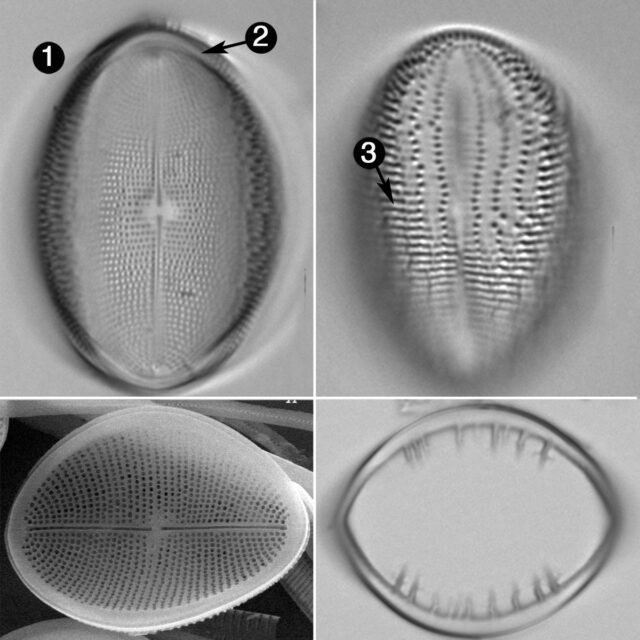
Cocconeis pediculus
- Saddle-shaped frustule
- Hyaline area on raphe valve margin
- Rapheless valve with transapically elongated areolae
The arched valves form saddle-shaped frustules. Striae on the raphe valve terminate before reaching the valve margin, creating an hyaline ring around the valve margin. Striae on the rapheless valve are transapically elongated.
 Diatoms of North America
Diatoms of North America